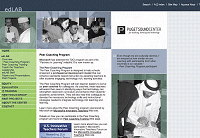Professional Development :: Arizona
##AUTHORSPLIT##<--->
A SUSTAINED EFFORT
In Arizona, one-and-done workshops are a thing of the past, replaced by ongoingprofessional development that enables teachers to use classroom technology to full effect.
IN MARCH, the Arizona Department of Education madea bold move by adopting a policy to infuse the National StaffDevelopment Council’s standards for staff development into the agency’s work. Accordingto Donna Campbell, director of professional development forthe Highly Qualified Professionals section of the state DoE,“The NSDC standards recognize that sustained staff developmentis vital for everyone who affects student learning.” Campbellgoes on to say that “these standards will guide allprofessional development interventions and will guide agencyinteractions with others in creating and providing professionaldevelopment activities.”
Arizona, like many other educational entities, has shifted technology training away from the “one-shot” workshops and “how to use” conferences and has begun to emphasize sustained professional development focused on supporting academic standards through the integration of technology. The models at work in Arizona, a sample of which is shown below, all reflect NSDC standards.
Peer Coaching
In northern Arizona, the technology integration partnership between Flagstaff Unified School District and Tuba City Unified School District #15—a product of an Enhancing Education Through Technology (EETT) grant—has been using peer coaching in support of tech-enhanced classrooms for the past three years. Two technology integration coaches are available throughout the school year and visit participating teachers a minimum of every two weeks. Their activities include training, modeling effective use of technology in instruction, and providing assistance with lesson design and equipment use. According to Mary Knight, Flagstaff USD’s director of management information services, “These sustained efforts have provided teachers with the support critical in transitioning to seamlessly utilizing technology in instruction.”
The use of individualized peer coaching continues to be the most effective approach used by Flagstaff USD, Knight says. In February, the district enrolled five staff members in the Peer Coaching Program created by the Puget Sound Center for Teaching, Learning and Technology in order to build the staff’s competence with this model.
Tucson’s ed tech lead trainer says peer observation—teachers watching how other teachers integrate technologyinto instruction—has been one of the most effectivePD strategies incorporated in the district this year.
Peer Observation
Tucson Unified School District is Arizona’s largest district, with more than 60,000 students, 3,700 teachers, 3,600 support staff, and 200 administrators. Its emphasis, as an EETT grantee, is on integrating technology into all kindergarten and first-grade classrooms, in addition to providing professional development in the use of the tools.
According to Ed Kowalczyk, Tucson’s ed tech lead trainer, “One of the most effective strategies incorporated this year has been providing release time for teachers to visit other teachers’ classrooms and to observe their teaching practices, technology integration strategies, and classroom management techniques.” At the end of the visits, the observed and observing teachers meet to talk about their notes and findings. Kowalczyk says that this give-and-take has increased his teachers’ level of technology integration and has led to significant changes in their classroom practices. In light of the success the district has had with the use of observations, it will continue the practice next school year.

Technology Integration Specialists
Arizona’s Statewide Instructional Technology (SIT) project, also funded with EETT money, provides all Arizona teachers with professional development in the use of technology. The project is primarily carried out through the work of full-time, certified technology integration specialists (TISs), who work out of their county Education Service Agency. The SIT program adopted NSDC standards as the framework for all of its professional development activities.
A good example of the sustained professional training provided by the project is the use of the Intel Teach Program’s Essentials professional development course. Not only do the TISs conduct the Intel training, but they also follow up and support the teachers as they implement the unit they created during the course.
Gila County has found a successful approach with theimplementation of a program featuring students as thetrainers of teachers.In the future, computation will be everywhere.
The work of Val Quatro in Cochise County in southeast Arizona is a good model. Quatro, the local TIS, works closely with the area school districts. She meets with the administrators, school leaders, and teachers to guide instructional improvement, and together they decide what technology series or workshops will be offered. Quatro reviews student data for each school she supports and points out specific strategies that would help increase academic achievement. She also includes ample time for dialogue among teachers that focuses on the data. Participating teachers can sign up for follow-up coaching, modeling, and mentoring for help in implementing the student-based projects into their classrooms during the series of trainings. In addition, teachers are forming much-needed professional learning communities to continue applying their new knowledge throughout the year.
Meanwhile, Gila County, in the central part of the state, has found a successful approach to sustained professional development with the implementation of a program featuring students as the trainers of teachers. According to Dan Reid, technology integration specialist for the region, the program is derived from Generation YES (Youth & Educators Succeeding), which believes in employing students to help integrate technology in schools. “Energized students can energize teachers,” Reid says. In all classrooms with trained students, Reid reports the use of technology has significantly risen, including a positive spike in the use of computer technology for completion of classroom assignments.
The use of all of these to professional development models has become operational throughout Arizona, as the state has embraced the notion of sustained professional development in its EETT grant activities, as well as through the work of the state education department. Educational technology is no longer seen as an “add-on,” but has become a vital tool in enhancing learning in the classroom.
-Cathy J. Poplin is the deputy associate superintendent for educational technology with the Arizona Department of Education.